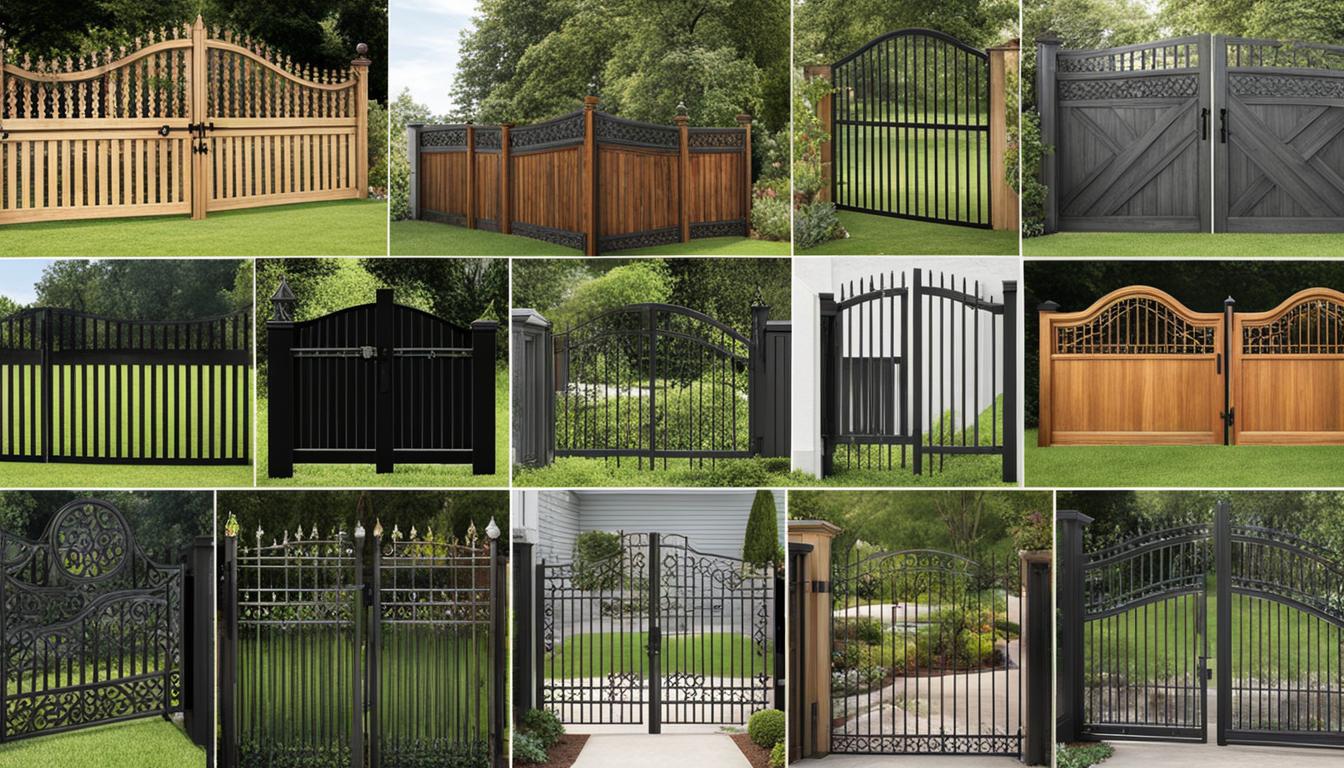When it comes to installing a fence, one important consideration is the number of gates it should have. Having the right number of gates can enhance the functionality and accessibility of your fence. In this comprehensive guide, we will explore the factors to consider when determining the number of gates for your fence, including the size of your property, the purpose of the fence, and the regulations in your area.
Key Takeaways
- Consider the size of your property when determining the number of gates for your fence.
- The purpose of the fence will also impact the number of gates required.
- Check the regulations in your area for any specific guidelines regarding gate quantity and placement.
- Having multiple gates on your fence offers benefits such as improved accessibility, better traffic flow, enhanced security, and increased aesthetic appeal.
- There are various gate options available, including swing gates, sliding gates, double gates, and automatic gates.
Benefits of Having Multiple Gates on Your Fence
Having multiple gates on your fence offers several advantages that can greatly enhance the functionality and convenience of your property. These benefits go beyond just providing additional access points. Let’s explore the various advantages of having multiple gates:
- Improved accessibility: Multiple gates make it easier for you, your family, and guests to enter and exit your property from various locations. This can greatly enhance convenience, especially if your property is large.
- Enhanced flow of foot traffic: If your property has different areas or zones, having multiple gates can improve the flow of foot traffic. It allows people to move between sections without having to go the long way around.
- Increased security: Multiple gates provide additional entry and exit options, which can be beneficial in case of emergencies. It allows for quicker and more efficient evacuation or access to specific areas of your property.
- Aesthetic appeal: Adding multiple gates to your fence can also contribute to its overall visual appeal. It provides variety and breaks up the monotony of a single gate design, making your fence more visually interesting.
By considering these benefits, you can see why having multiple gates on your fence is a practical and advantageous choice.
| Advantages | Description |
|---|---|
| Improved accessibility | Multiple gates make it easier to enter and exit your property from different locations. |
| Enhanced flow of foot traffic | Multiple gates facilitate movement between different areas or zones of your property. |
| Increased security | Having multiple gates provides additional entry and exit options, which can be crucial in emergencies. |
| Aesthetic appeal | Adding variety with multiple gates enhances the visual interest of your fence. |
Factors to Consider When Determining the Number of Gates
When it comes to determining the number of gates for your fence, there are several important factors to consider. These factors will help ensure that you choose the right quantity of gates to suit your needs, accessibility, and overall functionality.
The first factor to consider is the size of your property. Larger properties may require multiple gates to provide convenient access from different areas. Assess your property and identify the areas that require access, such as driveways, walkways, or separate zones. This will give you a better idea of how many gates you may need.
The purpose of your fence is another crucial consideration. If your fence is primarily for privacy, you may only require a smaller number of gates. However, if your fence is meant to provide access to certain areas like a garden, pool, or separate sections of your property, multiple gates may be necessary. By understanding the purpose of your fence, you can determine the appropriate quantity of gates.
Additionally, it is essential to be aware of the regulations and requirements in your area. Certain local regulations may dictate the number and placement of gates on your property. Make sure to research and comply with any guidelines to ensure that your fence and gates meet the necessary standards.
By carefully considering these factors – the size of your property, the purpose of your fence, and any regulations in your area – you can determine the right number of gates for your fence. Taking these considerations into account will help you choose gates that enhance the functionality, accessibility, and overall appeal of your fence.
Gate Options for Your Fence
When it comes to choosing the right gate for your fence, there are various options available to suit your needs and preferences. The type of gate you select can impact the functionality, security, and overall aesthetic appeal of your fence. Here are some common gate options:
1. Swing Gates
Swing gates are a traditional option that can swing inward or outward. They are versatile and can be designed to match the style of your fence. Swing gates are suitable for most properties and offer a classic look.
2. Sliding Gates
Sliding gates are an ideal choice for properties with limited space. These gates slide horizontally to open and close, saving space and providing a sleek and modern appearance. Sliding gates are often used for driveways or areas with restricted access.
3. Double Gates
Double gates consist of two separate panels that swing open or closed. They are perfect for wider openings and can add grandeur to your fence. Double gates provide a wider passage for vehicles and large items.
Additionally, there are options for automatic gates that can be operated with remote controls or keypads. These gates offer convenience and enhanced security, allowing you to open and close them with ease.
When selecting the right gate for your fence, consider factors such as your property size, desired level of security, and the overall design aesthetic you want to achieve. Consulting with a professional fence contractor can help you make an informed decision and ensure that the gate you choose complements your fence perfectly.
Tips for Choosing the Right Number of Gates for Your Fence
When it comes to selecting the number of gates for your fence, there are a few key tips to keep in mind. Consider the size of your property and the purpose of the fence. If you have a larger property, multiple gates may be necessary to ensure convenient access from different areas. On the other hand, if your fence is primarily for privacy, a smaller number of gates may suffice. Assess the areas that require access and determine the most convenient locations for gates.
Another important factor to consider is the flow of foot traffic. Think about how people will move throughout your property and identify the areas that will see the most activity. Placing gates in these areas will help improve the flow and accessibility. Additionally, take into account the overall aesthetic of your fence. Balance functionality and accessibility with the visual appeal of your gate design.
Consulting with a professional fence contractor is highly recommended when determining the number of gates for your fence. They can provide expert advice based on your specific needs and preferences. Their experience and knowledge will ensure that you make an informed decision and choose the right number of gates for your fence.
| Factors to Consider | Tips | |
|---|---|---|
| 1 | Size of your property | Install multiple gates for larger properties |
| 2 | Purpose of the fence | Assess if the fence is for privacy or providing access to specific areas |
| 3 | Flow of foot traffic | Place gates in areas that will see the most activity |
| 4 | Overall aesthetic | Balance functionality and accessibility with the visual appeal |
Installation and Maintenance of Fence Gates
Proper installation and regular maintenance are crucial for ensuring the optimal functionality and longevity of your fence gates. By following a few key steps, you can ensure that your gates are securely installed and well-maintained.
When it comes to gate installation, start by ensuring that the gates are securely attached to the fence posts. Double-check that the hinges are properly aligned and tightened, as loose hinges can compromise the stability of the gate. Test the gate’s movement to ensure it opens and closes smoothly. If you’re installing an automatic gate, make sure that the electrical connections are secure and that the gate operates correctly using the designated control mechanism.
Maintenance of fence gates is equally important. Regularly inspect the gates for any signs of wear and tear, such as loose hinges or damaged components. Lubricate the moving parts, such as hinges and latches, to prevent rust and ensure smooth operation. Check the alignment of the gates to ensure they close properly and are not sagging. Additionally, if you have an automatic gate system, regularly check and replace batteries or inspect electrical connections as needed.
By taking the time to install your fence gates properly and performing regular maintenance, you can ensure that they remain functional, secure, and visually appealing for years to come.
Table: Fence Gate Maintenance Checklist
| Task | Frequency | Action |
|---|---|---|
| Inspect hinges and latches | Monthly | Tighten loose components and lubricate with a silicone-based lubricant |
| Check gate alignment | Biannually | Adjust hinges and latches if necessary to ensure proper closure |
| Inspect and clean automatic gate system | Quarterly | Check electrical connections, replace batteries, and clean sensors |
| Remove debris | As needed | Regularly clear away leaves, dirt, and other debris that may obstruct gate movement |
Use this handy maintenance checklist as a guide to ensure that your fence gates receive the care and attention they need to remain in optimal condition. Remember, regular maintenance can help prevent costly repairs and extend the lifespan of your gates.
Conclusion
In conclusion, the number of gates you choose for your fence is a decision that should take into account several important factors. By carefully considering the size of your property, the purpose of the fence, and the regulations in your area, you can determine the right number of gates that will enhance the functionality and accessibility of your fence.
When selecting gate options, it’s essential to evaluate your specific needs and preferences. Whether you opt for swing gates, sliding gates, or double gates, each choice offers its own advantages and considerations. You may also want to explore the convenience and security offered by automatic gates, which can be operated with remote controls or keypads.
In summary, balancing functionality, accessibility, and visual appeal is crucial when choosing the right number of gates for your fence. It’s recommended to consult with a professional fence contractor who can provide expert advice based on your specific requirements. By making an informed decision and properly installing and maintaining your fence gates, you can enjoy the convenience, security, and aesthetic appeal they bring to your property.
FAQ
How many gates should I have on my fence?
The number of gates you should have on your fence depends on factors such as the size of your property, the purpose of the fence, and the regulations in your area.
What are the benefits of having multiple gates on my fence?
Having multiple gates provides additional access points to your property, improves the flow of foot traffic, enhances security, and adds aesthetic appeal.
What factors should I consider when determining the number of gates for my fence?
Consider the size of your property, the purpose of the fence, and the regulations in your area when determining the number of gates for your fence.
What are the different gate options for my fence?
Common gate types include swing gates, sliding gates, double gates, and automatic gates.
How do I choose the right number of gates for my fence?
Consider the size of your property, the purpose of the fence, the flow of foot traffic, and the overall aesthetics of your fence when choosing the number of gates.
How do I install and maintain fence gates?
Ensure secure attachment to fence posts during installation and regularly check for loose hinges, damaged components, and proper alignment. Regular maintenance includes lubricating moving parts and inspecting any automatic gate systems.




